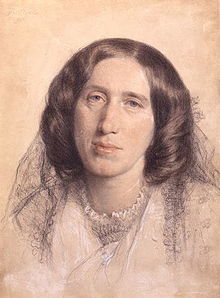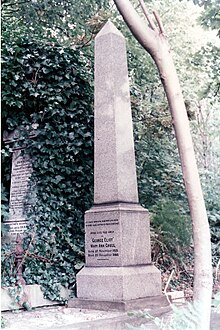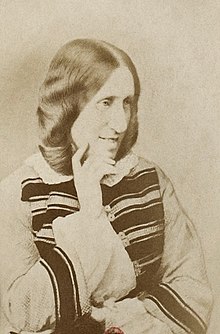George Eliot
George Eliot , actually Mary Anne Evans , (born November 22, 1819 in Nuneaton , County Warwickshire , † December 22, 1880 in London ) was an English writer , translator and journalist who was one of the most successful authors of the Victorian era . Novels like Middlemarch and Die Mühle am Floss are classics in English literature. In 2015, 82 international literary critics and scholars voted for the novel Middlemarchthe most important British novel .
Life
Childhood, youth and beginnings as a journalist
Mary Anne Evans was born in 1819 on the South Farm on the Arbury estate in Warwickshire, the daughter of the land manager Robert Evans and his second wife Christiana Pearson. She was the youngest of five children in the family, two of them from her father's first marriage.
She grew up at Griff House near Nuneaton and attended schools in Nuneaton and Coventry , where she was considered an excellent student. The position of her father gave Mary Anne Evans an insight into the life of the working class as well as the landed gentry and gave her access to the library of the estate. Influenced by a teacher, she turned to evangelicalism in 1834 .
Her mother died in 1836 when Mary Anne Evans was sixteen. At this point, Mary Anne was studying at home with the help of private tutors and was running the household with a sister. After her sister's marriage in 1837, Mary Anne had this duty alone. In the aftermath of her mother's death, she shortened her middle name to "Ann". When her brother Isaac married in 1841, he took over the family home and she and her father moved to Foleshill, a suburb of Coventry. There she gained access to the environment of the factory owner Charles Bray , Unitarian and supporter of Robert Owens , whose house was a meeting place for liberal free thinkers . This so-called Rosehill Circle gave her new insights into intellectual and religious questions. As a result, she gradually gave up her belief, which led to a conflict with her father.
During this time she began writing regularly for the Charles Brays newspaper and translated David Friedrich Strauss ' Das Leben Jesu into English. After the death of her father in 1849, whom she had cared for until the end of her life, she went on a trip through Europe with friends and settled in Geneva for several months. Back in England, she moved to London and worked under the name Marian Evans as an editor for the liberal magazine Westminster Review , with whose married editor she had a brief affair. Through her work she came into contact with many important British intellectuals of the time.
Relationship with George Henry Lewes
Through her acquaintance with Herbert Spencer , with whom she fell in love, but was rejected by her, Evans met the married author George Henry Lewes , with whom she began an open love affair. This “ wild marriage ” was a scandal at the time and was not appreciated by the couple's circle of friends either. Lewes, however, could not raise the money for a divorce, and since he had assumed paternity for a child of his wife who had not been fathered by him, he had thereby approved the adultery and could no longer bring it up as a reason for divorce.
No longer employed by the Westminster Review , Evans took over the translation of Ludwig Feuerbach's Das Wesen des Christianentums . In 1854 the couple went on a trip to Germany, where Lewes gathered material for a biography of Goethe and the two experienced a far more tolerant attitude towards their relationship among German intellectuals. On their return they settled as Mr. and Mrs. Lewes in Richmond, South West London .
Entry into fiction
In 1857, Blackwood's Edinburgh Magazine published the short story The Sad Fortunes of the Reverend Amos Barton Marian Lewes' first fiction work. The manuscript was sent to the publisher by George Henry Lewes; a man named "George Eliot" was given as the author, whose name became Marian Lewes' literary pseudonym. Amos Barton was published in 1858 as a book together with the two short stories Mr. Gilfil's Love Story and Janet's Repentance , which were also published in Blackwood's Magazine , under the title Scenes of Clerical Life by Blackwood and received praise. During this period of her first literary success, Marian's brother Isaac, to whom she felt very close, learned of the nature of her relationship with George Henry Lewes and broke off all contact with her.
Success as a novelist
In 1859 George Eliot published her first novel Adam Bede , which became a bestseller. As in her short stories, she portrayed characters she knew from the rural life of her youth in Warwickshire. Even before the publication of her next novel, it became known who was hiding behind the pseudonym. The mill on the raft came out in 1860 and was heavily based on her own biography. Silas Marner followed in 1861 . For the Romola series of novels published from 1862 to 1863 , she switched to Blackwood competitor Cornhill Magazine due to a lucrative offer , but the historical novel turned out to be a failure. With Felix Holt, The Radical (1866), which she settled in the time of the Reform Act 1832 , she returned to Blackwood. In her novel Middlemarch , published from December 1871, George Eliot described life in a fictional small town of the same name in the Midlands around 1830. Middlemarch was her greatest success. George Eliot's last novel, Daniel Deronda , was published in 1876.
Her work was very successful and had a considerable influence on English literature. Again and again she took up philosophical and socio-political problems in later works. Their free and revolutionary thoughts did not meet with approval everywhere. However, due to its great success, it was gradually resumed by society. After GH Lewes' death on May 6, 1880, she married John W. Cross, 20 years her junior, who threw himself out of the window of his hotel room in Venice into a canal on his honeymoon , but survived. Mary Ann Evans was an important member of London's spiritual life, where she died on December 22, 1880. Her grave is in London's Highgate Cemetery .
Name changes
George Eliot used at least seven names in her life: She was born as "Mary Anne Evans", corresponded with her strictly religious first teacher and friend Maria Lewis as "Clematis", called herself "Mary Ann Evans" after the death of her mother Moving to London she had great success as "Marian Evans" as manager of the Westminster Review , snubbed prudish society as "Marian Evans Lewes", came to world fame as "George Eliot" and finally died as the respectable wife "Mary Ann Cross".
Aftermath
John Boyne referred to Eliot in The Tale of Loneliness to support his criticism of Irish Catholicism , particularly for its views on sexuality. In the library of the seminary that the two main characters attend, Middlemarch counts as forbidden reading because of playing with gender roles.
Works
Novels
- Adam Bede (1859)
- The mill on the raft (1860)
- Silas Marner (1861)
- Romola (1862-63)
-
Felix Holt, The Radical (1866)
- Felix Holt, the radical , translated by Emil Lehmann, O. Janke, Berlin 1867
-
Middlemarch (1871-72)
- Middlemarch. A study about life in the provinces , translated by Melanie Walz . Rowohlt Verlag, Hamburg 2019, ISBN 978-3-498-04537-1 .
- Daniel Deronda (1876)
stories
-
Scenes of Clerical Life (1858)
- The Sad Fortunes of the Reverend Amos Barton (1857)
- Mr. Gilfil's Love Story (1857)
- Janet's Repentance (1857)
- The Lifted Veil (1859)
- Brother Jacob (1864)
-
Three Months in Weimar (1855).
- A guest in Weimar . German by Nadine Erler . Bertuch Verlag, Weimar 2019.
Film adaptations
- 1994: Middlemarch
- 2002: Daniel Deronda
literature
- Rosemary Bodenheimer: The Real Life of Mary Ann Evans. Cornell University Press, Ithaca 1994, ISBN 0-8014-2988-9 .
- Catharina Boerckel: Ideal and Reality: Female Development Processes in Jane Austen , Elizabeth Gaskell and George Eliot (= Anglo-American Studies , Volume 10). Lang, Frankfurt am Main / Berlin / Bern / New York / Paris / Vienna 1997, ISBN 3-631-31706-9 . (Dissertation University of Mainz 1996.)
- Tim Dolin: George Eliot (= Oxford World's Classics. Authors in Context ). Oxford University Press, 2005, ISBN 0-19-284047-9 .
- Helene von Druskowitz : Three English poets ( Joanna Baillie , Elizabeth Barrett Browning , George Eliot) , essays. Robert Oppenheim, Berlin 1885, OCLC 6696737 ( Austrian Literature Online University Innsbruck).
- Nancy Henry: The Cambridge Introduction to George Eliot. Cambridge University Press, New York NY 2008, ISBN 978-0-521-85462-7 .
- Dies .: The life of George Eliot: a critical biography. Wiley-Blackwell, Chichester 2012, ISBN 978-1-405-13705-8 .
- Kathryn Hughes : George Eliot: The Last Victorian. Farrar, Strauss, Giroux, 1999.
- Jan Jędrzejewski: George Eliot. Routledge, London 2007, ISBN 978-0-415-20249-7 .
- George Levine: The Cambridge Companion to George Eliot. Cambridge University Press, New York 2001, ISBN 978-0-521-66267-3 .
- Elsemarie Maletzke : George Eliot. Insel, Frankfurt am Main 1993, ISBN 3-458-33673-7 .
- Carol A. Martin: George Eliot's Serial Fiction . Ohio State University Press, Columbus OH 1994, ISBN 0-8142-0625-5 . ( Full access to digital content on the publisher's website).
- Meinhard Winkgens: The cultural symbolism of speech and writing in the novels of George Eliot: Investigations into their development, functionalization and evaluation (= ScriptOralia , Volume 93). Narr, Tübingen 1997, ISBN 3-8233-5403-5 .
Web links
- Literature by and about George Eliot in the catalog of the German National Library
- Works by and about George Eliot in the German Digital Library
- Works by George Eliot in the Gutenberg-DE project
- Works by George Eliot (English)
- David Walsh : On the 150th anniversary of the publication of your novel "Adam Bede". Part 1 , part 2
- 2010: George Eliot's "Middlemarch": The Making of a Modern Marriage. Author: Katherine Marie Kelly. Diss. Phil. University of New Orleans
- Jutta Duhm-Heitzman: November 22, 1819 - George Eliot's birthday, WDR ZeitZeichen, November 22, 2019 (podcast)
- George Eliot in Dresden. https://www.dresden-lese.de/index.php?article_id=405
- George Eliot in Berlin: https://www.berlin-lese.de/index.php?article_id=552
Individual evidence
- ↑ The best British novel of all times - have international critics found it? In: The Guardian , accessed January 2, 2016
- ^ A b Nancy Henry: The Cambridge Introduction to George Eliot . P. 1.
- ^ A b Nancy Henry: The Cambridge Introduction to George Eliot . P. 2f.
- ↑ Tim Dolin: George Eliot. P. 9.
- ↑ Rosemarie Bodenheimer: A woman of many names . In: George Levine (Ed.): The Cambridge Companion to George Eliot. P. 22.
- ↑ Tim Dolin: George Eliot. P. 11f.
- ^ Nancy Henry: The Cambridge Introduction to George Eliot . P. 4.
- ^ Nancy Henry: The Cambridge Introduction to George Eliot . P. 5f.
- ↑ Gerlinde Röder-Bolton: George Eliot in Germany, 1854-55: 'Cherished Memories'. Burlington: Ashgate Publishing, 2006. ISBN 0754650545 , p. 139.
- ^ Nancy Henry: The Cambridge Introduction to George Eliot. P. 7.
- ↑ Rosemarie Bodenheimer: A woman of many names. In: George Levine (Ed.): The Cambridge Companion to George Eliot. P. 29 f.
- ^ Nancy Henry: The Cambridge Introduction to George Eliot . P. 8.
- ↑ Rosemarie Bodenheimer: A woman of many names . In: George Levine (Ed.): The Cambridge Companion to George Eliot. P. 30 f.
- ^ Nancy Henry: The Cambridge Introduction to George Eliot. P. 9f.
- ↑ knerger.de: The grave of George Eliot
| personal data | |
|---|---|
| SURNAME | Eliot, George |
| ALTERNATIVE NAMES | Evans, Mary Anne (real name) |
| BRIEF DESCRIPTION | English writer |
| DATE OF BIRTH | November 22, 1819 |
| PLACE OF BIRTH | Nuneaton , Warwickshire |
| DATE OF DEATH | December 22, 1880 |
| Place of death | London |



